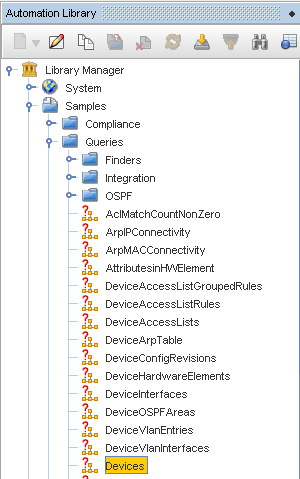Shown in the following graphic is the Automation Library navigation tree, with a specific Sample Query (Device By Name) selected, and a sample Query Result on the right.
The Query Results are shown in a tab labeled Result View (and includes the Query name). Think of a result view as similar to a spreadsheet page.
-
The first row is a set of column headers that are constructed from the DisplayNames of each attribute returned in the Query.
-
The remaining rows in the result view show data returned by the Query. Each row may have data from one or more objects in the model.
As shown, the Queries folder contains a sub-folder named Finders, which is expanded to show a great many Queries that are shipped as examples with Network Configuration Manager.
Each of the Finder queries finds objects of a particular type, searched for by a particular criteria.

For example, the highlighted Query is Device,which allows you to search for Devices based on their Device attribute.

You can run a Query (shown in the Automation Library tree) by double-clicking the Query name. Some Queries run immediately and display their results, which are shown in a Result View. Other Queries may prompt for one or more input parameters that limit their results.
The Finder Queries all prompt for an input parameter which can generally be identified from their name (such as Device By Name, will prompt for the Device Name).
When a Finder prompts for a name or other string, it can generally be supplied as a partial regular expression. For example, to find all the Devices that contain the characters dev, enter that string for the parameter, and press Enter.
Alternately, to see all the Devices, press ENTER at the prompt, without supplying any input.
In more formal terms, a selection is applied to the Query based on the entered text. If text represents the text that is entered, a selection is performed according to the regular expression . *text.*, which will match the input regular expression with arbitrary characters in preceding it, or succeeding it.
Some Finder Queries prompt for an IP address instead (these are typically named "– by Subnet Containing IP".)